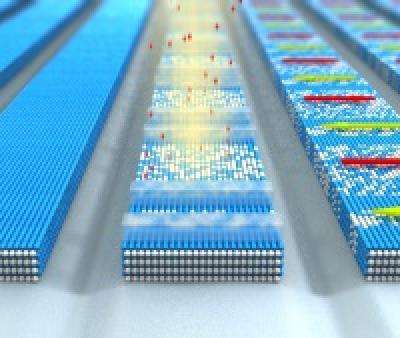Ion beams pave way to new kinds of valves for use in spintronics

Researchers at the Helmholtz-Zentrum Dresden-Rossendorf (HZDR) have tested a new approach to fabricating spin valves. Using ion beams, the researchers have succeeded in structuring an iron aluminium alloy in such a way as to subdivide the material into individually magnetizable regions at the nanometer scale. The prepared alloy is thus able to function as a spin valve, which is of great interest as a candidate component for use in spintronics. Not only does this technology use electron charge for purposes of information storage and processing, it also draws on its inherent magnetic properties (that is, its spin). Spintronics holds great potential for magnetic storage media. For example, with magnetic random access memories a computer's time-consuming start-up phase may cease to be an issue – as in that case it would be operational as soon as it is switched on.
Typically, a spin valve is made up of successive non-magnetic and ferromagnetic layers. This layering is a very involved process and getting these components to connect reliably presents a major challenge. This is why HZDR researcher Dr. Rantej Bali and his colleagues are taking an entirely different approach. "We've built structures with lateral spin valve geometry where the different magnetic regions are organized one next to the other as opposed to in layers one on top of the other," explains Bali. The idea behind this new geometry is to facilitate working in parallel on larger surfaces while keeping fabrication costs low.
First, the scientists annealed a thin layer of an iron aluminum alloy (Fe60Al40) at 500 degrees C. This resulted in formation of a highly ordered structure, where every other atomic layer was made up exclusively of iron atoms. According to the researchers' expectations, this substance behaved as a paramagnetic material – in other words, the magnetic moments became disordered. After this, the scientists coated the alloy with a protective polymer resist so that a striped pattern was produced on its surface. The resist-free regions were alternatingly 2 and 0.5 micrometers wide, and crucially, were separated from each other by 40 nanometer wide strips of resist.
Next, the material was irradiated with neon ions at the HZDR's Ion Beam Center – with important consequences. The scientists were able to demonstrate that the irradiated material exhibits very interesting properties. Beneath the protective resist strips, the material remains paramagnetic while the resist-free narrow and wide stripes actually become ferromagnetic. "A spin valve is switched via the magnetic field. Changing the spins' alignment – parallel or antiparallel – changes the electrical resistance. We're interested in the magnitude of the effect," says Bali. An externally applied magnetic field aligns the spins within these regions. Depending on the magnetic field's strength, they can be adjusted to run in parallel or antiparallel. This magnetization is permanent and is not lost if the outer field is switched off.
The reason for this behavior lies in the fact that the ion beam changes the alloy's structure. "The ions destroy the iron layers' highly ordered structure. They knock the atoms out of position and other atoms take their place, and, as a result, the iron and aluminum atoms become randomly distributed," explains Sebastian Wintz, a Ph.D. student who was part of the team of researchers. A small dose of ions is enough to play this atomic-level game of tag. Wintz characterizes the process as follows: "It's a cascade, really. A single ion is capable of displacing up to 100 atoms." The regions beneath the polymer resist stripes, on the other hand, are impenetrable to the ions – which is why these regions remain paramagnetic and separate out the ferromagnetic stripes.
Collaboration with the Helmholtz Center Berlin Working closely with researchers at the Helmholtz Center Berlin (HZB), the HZDR scientists were able to visualize the material's magnetic structure using the special SPEEM (spin-resolved photoemission microscope) at the HZB's BESSY II synchrotron. The microscopic images showed the existence of regions with paramagnetic and ferromagnetic order demonstrating the high level of spatial resolution that can be realized by the structuring process using ion beams.
Additional experiments will allow Rantej Bali and his colleagues to investigate the properties of these magnetically structured materials. The researchers are also trying to figure out the limits to miniaturization of magnetic nanostructures.
More information: Rantej Bali et al., Nano Letters 14, 435 (2014), DOI: 10.1021/nl404521c
Journal information: Nano Letters
Provided by Helmholtz Association of German Research Centres




















